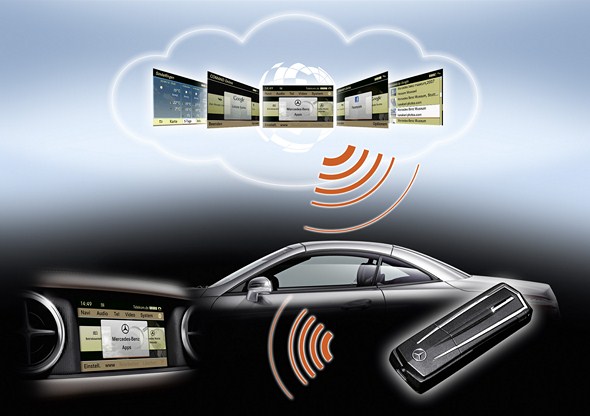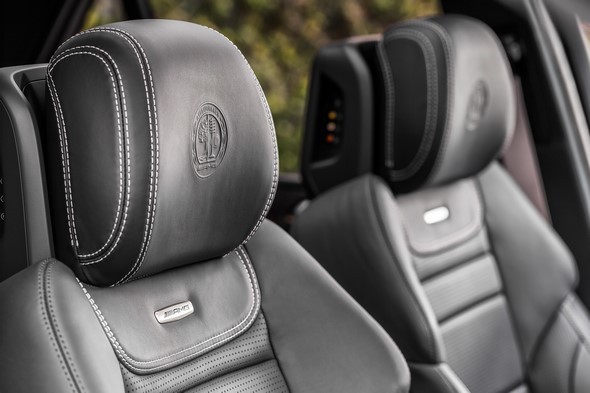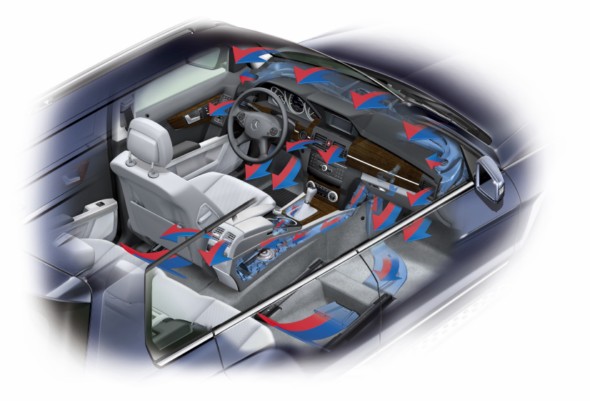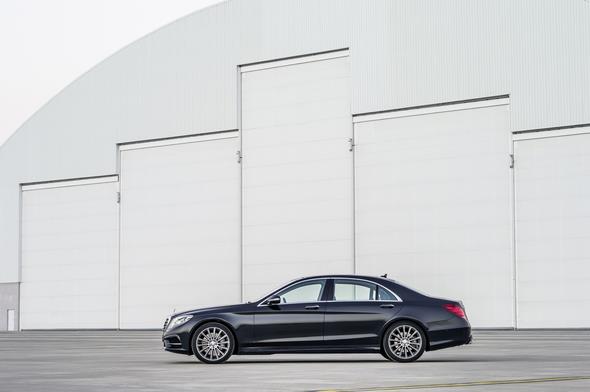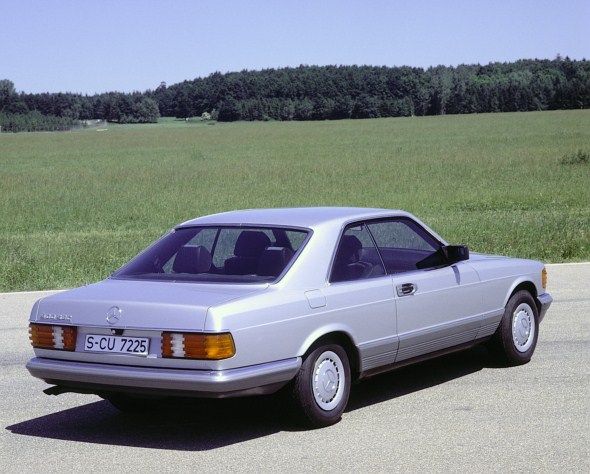Mercedes-Benz TecDay “S-Class Ambience: The Essence of Luxury”
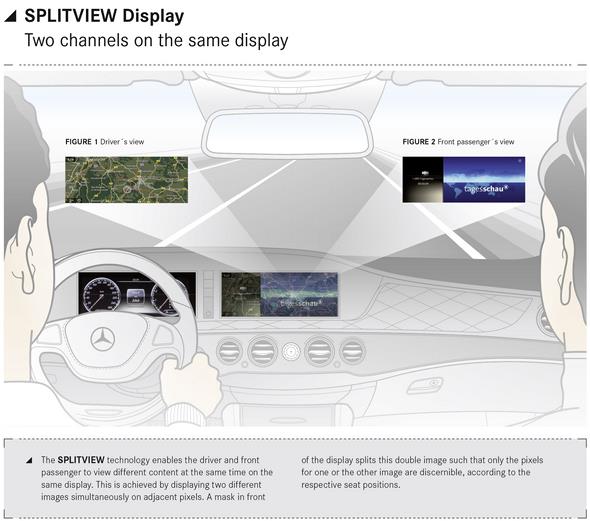

The assignment: Perfection
Stuttgart. The best automobile in the world – every new generation of the Mercedes-Benz S-Class has earned this accolade anew for itself.
The logical goal in the book of specifications for the coming model was therefore: perfection to the last detail. The result is “The Essence of Luxury”.
This pursuit of the best or nothing is particularly noticeable in the interior: whether it is the seats or the air conditioning, the controls or the design, the infotainment or the comfort and safety in the rear – new ideas and their painstaking realisation underpin the high standards that the engineers have set for the Mercedes-Benz flagship model – and for themselves.
For the first time in the history of the S-Class, the development focus was on the long-wheelbase Saloon. Unlike before, the standard-wheelbase version was derived from this.
This is because the S-Class is not only firmly positioned as a prestige saloon in the large overseas markets such as the USA, China or Japan.
Whereas in Europe and North America the owner of an S-Class is frequently behind the wheel themself, the flagship model in the Mercedes-Benz passenger car portfolio is very definitely a chauffeur-driven vehicle in Asia.
The logical consequence is the number of new features specifically related to comfort and safety in the rear – in the S-Class, there is no doubt that passengers in the rear are also seated in first class.
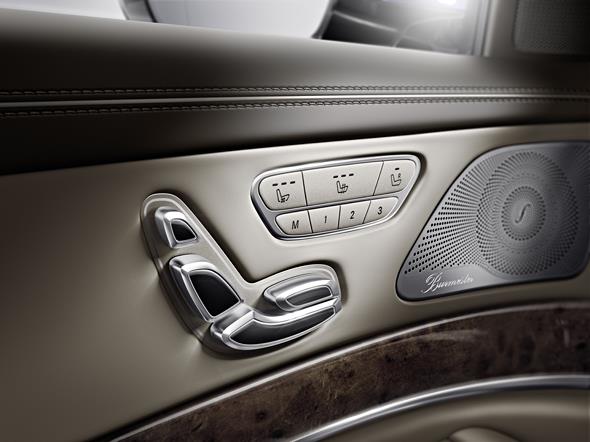
Not that the driver lacks for anything: the very latest Mercedes-Benz research findings have been incorporated into his immediate surroundings.
These clearly confirm that certain comfort characteristics have a direct influence over driver fitness and wellbeing during and after a journey. Comfort is also conducive to safety.
The new S-Class features highly sophisticated, automatic climate control functions. The seats likewise lay claim to being the benchmark in automobile engineering.
In both cases this is accompanied by maximum operating convenience, ensured by numerous actuators and electric motors – there are over 100 of these in the interior alone.
Interior design: visual breadth and calm solidity
With its clear-cut architecture, the interior design of the new S-Class is the embodiment of a classic, serene and yet ultra-modern saloon car. The interior space derives its expressiveness from a distinctively flowing, sensual and elegant style.
Horizontal features and lines create an ambience characterised by visual breadth and calm solidity. Where high quality and elegance go hand in hand with clarity and functionality.
The interior concept of the S-Class combines driving, spatial and operating comfort at the highest level.
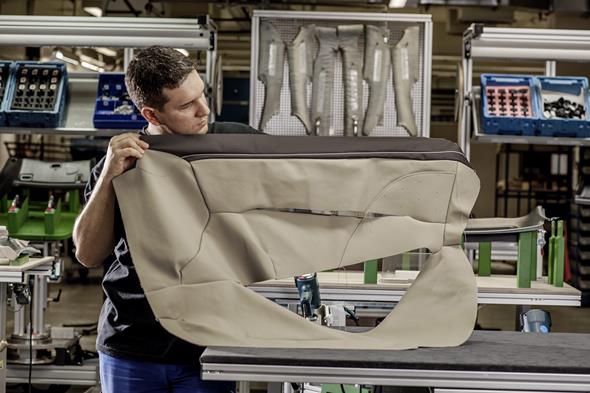
The perfectly coordinated use of materials and colours produces an exclusive interior seemingly cast from a single mould.
There is generous use of wood trim, especially in the dashboard and centre console.
Metallised switch surfaces with pearl-effect paint finishes in three colour shades to suit the interior colour particularly highlight the outstanding quality.
Passengers in the rear are also seated in first-class – the design and exclusivity of the seats, door panels and all controls are to the same, high standard as the front.
As an additional individualisation feature, the “First Class Rear” incorporates a Business centre console combining personal comfort with practical convenience (integration of a telephone handset, additional stowage compartments, folding table, etc.).
New control and display concept: elegant new command centre
The radically redesigned display extends in front of the driver as a key element of the horizontal alignment.
It replaces the traditional instrument cluster and combines numerous other functions in a visually and ergonomically highly sophisticated manner.
The entire display appears to be free-floating, an impression reinforced by “corona effect” ambience backlighting.
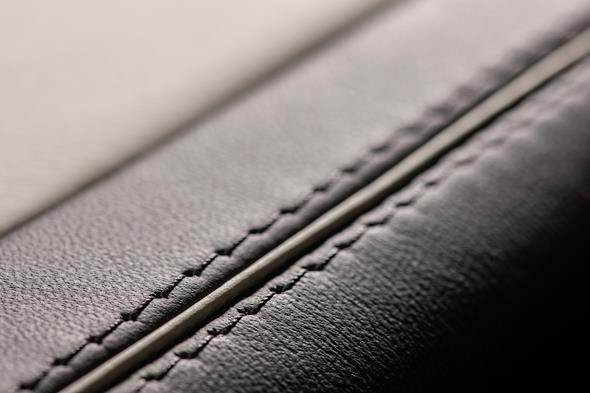
Two high-resolution colour displays in 8:3 format with a screen diagonal of 30.7 cm (12.3 inches) form the new information centre in the S-Class.
The left-hand display performs the functions of the previous instrument cluster, providing the driver with all relevant information.
The right-hand display allows the convenient control of infotainment and comfort functions.
Ergonomics, operating convenience and safety were the main considerations for the newly designed control and display concept.
For the S-Class, the constantly increasing need to integrate additional functions into the vehicle led to a further development of the entire operating logic.
The aim in designing the control and display features was to group controls and display functions together in a coherent manner in terms of both design and functionality.
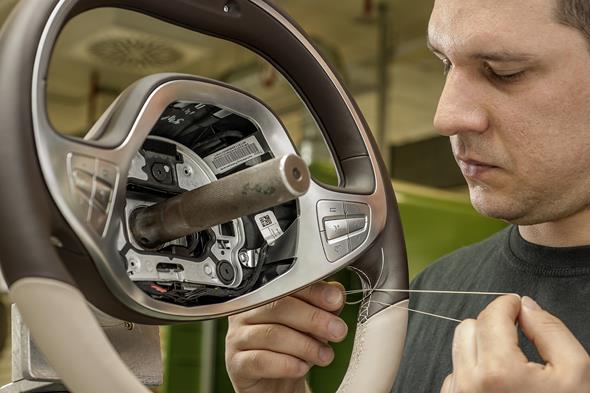
Apart from the new displays, the metallised switch surfaces and solid aluminium controls are visual highlights of particularly high quality.
Seats: mobile office and centre of wellbeing
With numerous world firsts such as the ENERGIZING massage function on the hot-stone principle or active seat ventilation with reversing fans, Mercedes-Benz has raised the seating and climatic comfort in the S-Class to a new level.
There is a choice of five different rear seat variants including an Executive seat with a backrest angle adjustable by up to 43.5 degrees, allowing occupants in the rear to concentrate on work or relax in comfort.
A large number of innovations enhance seating and climatic comfort. The ENERGIZING massage function on the hot-stone principle is a world first.
Working together with physiotherapists and psychologists, the seat specialists at Mercedes-Benz have developed a unique massage function with 14 separately actuated air cushions in the backrest, as well as an integrated warming function.
There is a choice of six massage programmes, two of them using the warming function.
For the first time, so-called reversing fans are used in the active seat ventilation system. Here the rotational direction of the fan, and therefore the airflow within the seat structure, can be reversed.
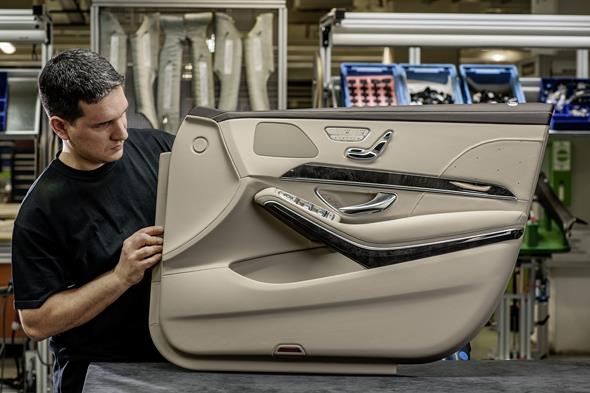
When the ventilation function first begins, cooler surrounding air is drawn onto the seat surface.
After four minutes the fans are automatically switched to blower mode to reduce draughts and therefore ensure sustained comfort.
Another world first as part of the Warmth Comfort package is the heated armrests and door centre panels in the front and rear (door and centre armrests).
The package also includes a heated steering wheel and particularly fast-responding seat heating Plus.
Each occupant is able to find the ideal level of climatic seating comfort. The heating output can be adjusted using the central display or the remote control in the rear.
Luxury or reclining seat in the rear: new backrest concept
Two rear seat variants (static bench seat or individual seats with 37-degree adjustment) are available for the standard-wheelbase S-Class and no less than five for the long-wheelbase version.
Unlike the conventional trailing backrest design, the backrest is adjusted separately so that the legroom and seat reference point remain unchanged.
The cushion can be separately adjusted for angle and horizontal position.
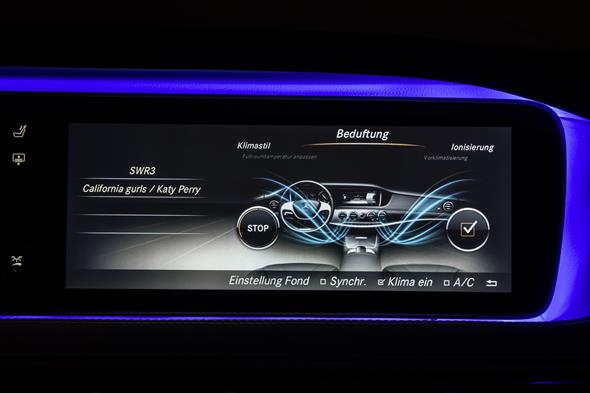
The maximum backrest angle of the reclining seat on the front passenger side is increased from 37 to 43.5 degrees, giving it the largest backrest inclination in the luxury segment.
The reclining seat behind the front passenger seat features a calf support which is freely adjustable for length and angle.
In combination with the heel rest on the forward-folding chauffeur seat, this allows a reclined position that sets new standards in the automobile sector with respect to sleeping and resting comfort.
Three new features improve safety in the rear: in the belt buckle feeder an electric motor automatically raises and lowers the buckle.
The beltbag is an inflatable seat-belt strap that is able to reduce the risk of injury to passengers in the rear in a head-on collision by lessening the strain on the ribcage.
The reclining seat is fitted with a cushionbag as standard. This prevents the occupant from sliding under the belt in the event of an accident.
In this way Mercedes-Benz has been able to design a comfortable reclining seat which provides a higher level of accident safety than a seat with a trailing backrest.
Climate control: many new features for a pleasant atmosphere
The newly developed climate control unit of the THERMOTRONIC automatic climate control included as standard has a mass flow regulating concept whose automatic operating principle meets individual comfort requirements for every occupant.
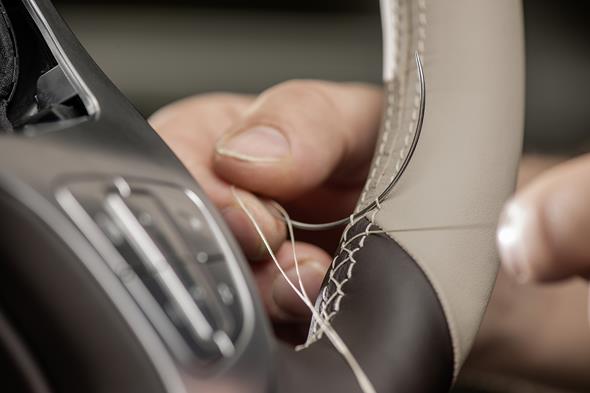
New features include completely autonomous adjustment options for the driver and front passenger sides, also for the individual automatic modes with their climatic settings of “Focus”, “Medium” and “Diffuse”.
As a world first, the new S-Class Saloon has an “active perfuming system” as part of the AIR-BALANCE package.
‘Active’ means that the perfuming system is switched on and off manually, with manual adjustment of the intensity.
The perfume atomisation system individualises the smell of the vehicle interior. It neither changes the interior smell permanently, nor are perfume molecules deposited on fabric surfaces or clothing.
Another feature of the AIR-BALANCE package is improved filtering of the outside air fed into the vehicle interior by the climate control system, and of the air recirculating in the interior in air recirculation mode.
The filter system is now even more efficient, and is able to reduce the peak levels of certain gaseous emissions while lowering their concentration below the perception threshold.
Ionisation is another component of the AIR-BALANCE package, the air from the climate control unit being conducted into the interior via an ioniser.
In a combined operating mode this renders certain viruses, bacteria and spores inactive (cleaning effect).
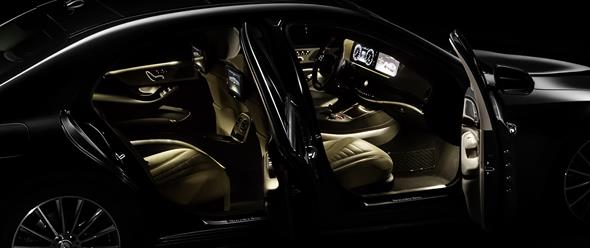
At the same time the air can be freshened by an increased concentration of negatively charged oxygen ions (relaxing effect).
Multimedia features: communication centre and concert hall
A completely new multimedia generation with intuitive operation and particularly tangible functions thanks to visualisation and animations celebrates its debut in the new S-Class.
Other innovations include the multi-user system, which allows independent access to the media sources of the entertainment system from any seat.
The new S-Class is also the first saloon car to be equipped with the unique Frontbass system as standard.
With this system, the woofers are installed within the bodyshell and use the almost 40‑litre space in the cross-member and side member as a resonance chamber.
Several hundred developers worldwide contributed to the new Mercedes-Benz multimedia generation, compiling more than 30 million lines of programming.
The centrepiece of the new COMAND Online system is the Intel Atom, a processor whose performance fully equals that of components in the latest laptops.
Numerous new functions extend the multimedia options available, and transform the S-Class into a communication centre or a concert hall as required.
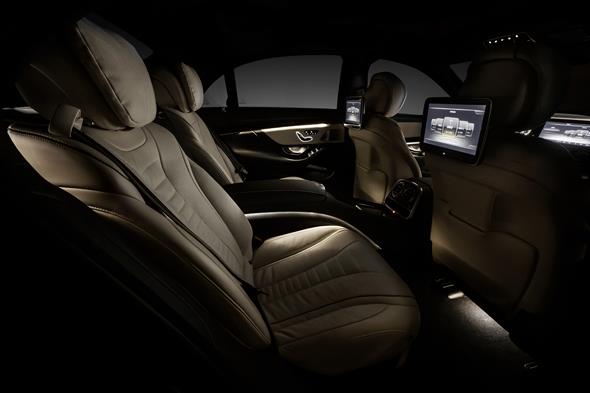
The new S-Class is the first vehicle worldwide to offer a genuine multi-user system for entertainment functions.
This means that there is independent access to the media sources of the entertainment system from any of the four seats – i.e. radio, TV, internet, navigation, DVD player and USB-connected devices.
The driver control function for all the seats is another new feature. The driver is able to route any audio or video source to the display and headset of any passenger.
At the touch of a button the driver is also able to have one of the audio sources in use played via the onboard loudspeakers.
The innovative Frontbass system developed by Mercedes-Benz and used for the first time in a saloon car is a feature common to all the audio systems: the woofers are housed in the firewall, and use the almost 40-litre space in the cross-member and side member as a resonance chamber.
As alternatives to the standard sound system with ten loudspeakers, two very high-quality audio systems are available which were developed together with hi-fi specialists at Burmester: Burmester® Surround Sound system and Burmester® High-End 3D Surround Sound system.
The interactive presentation of content is a prominent new feature of the navigation function.
The new navitainment functions include an animated compass, the “Driveshow” for passenger information as in an aircraft, and the display of Google Maps on the head unit and in the rear.
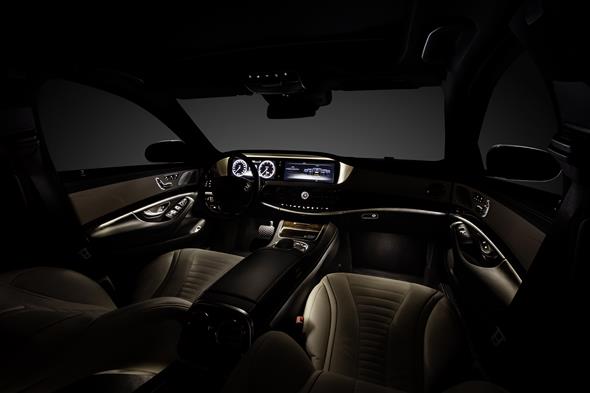
Interior design
Visual breadth and calm solidity
With its clear-cut architecture, the interior design of the new S-Class is the embodiment of a classic, serene and yet ultra-modern saloon car.
The interior space derives its expressiveness from a distinctively flowing, sensual and elegant style.
Horizontal features and lines create an ambience characterised by visual breadth and calm solidity. High quality and elegance go hand in hand with clarity and functionality.
The interior concept of the S-Class combines driving, spatial and operating comfort at the highest level.
The radically redesigned display extends behind the two-spoke steering wheel – reminiscent of the S-Class heritage – as a major part of the horizontal alignment.
It replaces the traditional instrument cluster and combines numerous other functions in a visually and ergonomically highly sophisticated manner (see section “New display concept”).
The entire display unit appears to be free-floating, an impression reinforced by ambience backlighting.
The high-quality unit formed by the centre air vents and the analogue clock is precisely set into three-dimensional wood trim. For the first time this classic wood trim feature is positioned very low.
This creates a second level of decorative trim whose luxurious stitched leather lies in the primary field of vision. Both levels extend elegantly across the entire width of the dashboard and doors.
With this layout the designers have created an association with the wingbeat of a bird. The result is an extraordinary impression of width combined with a pleasant, calm ambience.
The visually prominent dashboard is characterised by the striking double-S curve. This already made the preceding model unmistakable, and imparts a feeling of spaciousness, safety and security.
The perfectly coordinated use of materials and colours produces an elegant interior seemingly cast from a single mould. There is generous use of wood trim, especially in the dashboard and centre console.
Metallised switch surfaces with pearl-effect paint finishes in three colour shades to suit the interior colour particularly highlight the outstanding quality.
Innovative lighting systems in the form of a continuous light band under the wood trim strips and the central display – a completely new dimension in ambience lighting – and elegant lighting units with stylish details in the headlining enhance the comfortable atmosphere.
The number and size of the stowage facilities in the interior have been greatly increased compared to the preceding model.
Passengers in the rear are also seated in first-class – the design and exclusivity of the seats, door panels and all controls are to the same, high standard as the front.
If a luxury or reclining seat (Executive seat) is specified for the rear, the backrest inclines backwards into the parcel shelf, which means that legroom is not restricted even in the resting position.
As an additional individualisation feature, the “First Class Rear” incorporates a Business centre console combining personal comfort with practical convenience (integration of a telephone handset, additional stowage compartments, folding table, etc.).
The side finishers of the front seats are formally integrated and feature useful stowage compartments (for details see section “Seats”).
In combination with the first-class quality of materials and outstandingly high perceived value, the decidedly varied range of available appointments emphatically confirms the premium positioning of Mercedes-Benz.
The innovative architecture of the interior design, which is based on both additive and integrating features, allows a choice of different and very individual styling in terms of colours and materials.
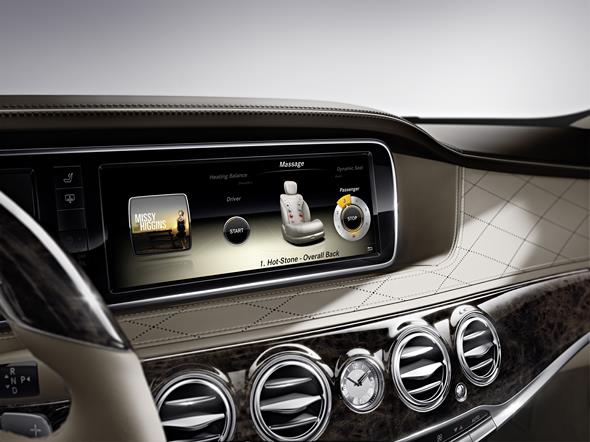
The standard appointments already meet high expectations. They include leather seat upholstery, elegantly finished wood trim and surfaces with decorative topstitching.
Various leather versions are available as optional extras, differing in their surface finish (e.g. patterned perforations and a hand-quilted look and feel), and also in terms of the relative leather and trim surfaces.
The customer also has a choice of five interior colour arrangements combined with five different types of exotic wood trim.
The interior design of the new S-Class was also influenced by the Mercedes-Benz Advanced Interior Design Studio in Como, whose primary task was also to explore how the highest possible perceived quality can be created.
Using the so-called “appreciation model”, the designers were able to give free rein to their imagination and look for ways of translating these ideals into series production features.
This led to a harmonious and luxurious interior whose design, character and perceived value are unrivalled.
Under the microscope: perceived quality
“Perceived quality does not depend on the spirit of the age”
When do customers perceive a vehicle interior as high in quality? Fundamental questions like this are an area of activity covered by Dr. Götz Renner, 49, head of the Customer Research Center (CRC) at Mercedes-Benz.
Dr. Renner, everybody talks about the perceived quality of a vehicle’s interior, but when exactly do customers consider an interior to be of high quality?
A combination of many attributes makes the difference. Deciding factors include the appearance of the materials and how they feel, intuitive understanding of control functions, a feeling of wellbeing, the precision of finish and the internal consistency of the design, the variety of features provided and the impression of solidity.
Taken together, these factors create a rewarding feeling that the customer has obtained good value for their purchase price, enabling them to experience lasting pleasure and satisfaction. All of this is naturally also influenced by fashion, but is nonetheless relatively independent of the spirit of the age.
You refer to a lasting feeling of pleasure, but is the first impression not just as important?
Both are important: just as when we meet other people, much is decided by the initial visual impression during the first few seconds. A high-quality interior therefore needs visual highlights that favourably influence the first impression.
An unsuitable detail that can spoil the overall impression is correspondingly unfortunate. But in the long run all the human senses are involved in our feeling of wellbeing: your sense of smell determines whether you are attracted or repelled, the ears whether you are disturbed or feel welcome.
And if your sense of touch tells you that you want to feel this surface again and again, we have won.
So how are these findings from behavioural psychology used in the development of a new automobile?
Mercedes-Benz design has reversed its approach in recent times. It is no longer a matter of subsequently upgrading and enhancing a functional interior. Instead the so-called “appreciation model” is at the start of the process.
Here the designers first put their creative ideals into practice, then look for ways in which their ideas can be translated into series production. This produces a more harmonious and higher-quality result.
The seats
Mobile office and centre of wellbeing
With numerous world firsts such as the ENERGIZING massage function on the hot-stone principle or active seat ventilation with reversing fans, Mercedes-Benz has raised seating and climatic comfort in the S-Class to a new level.
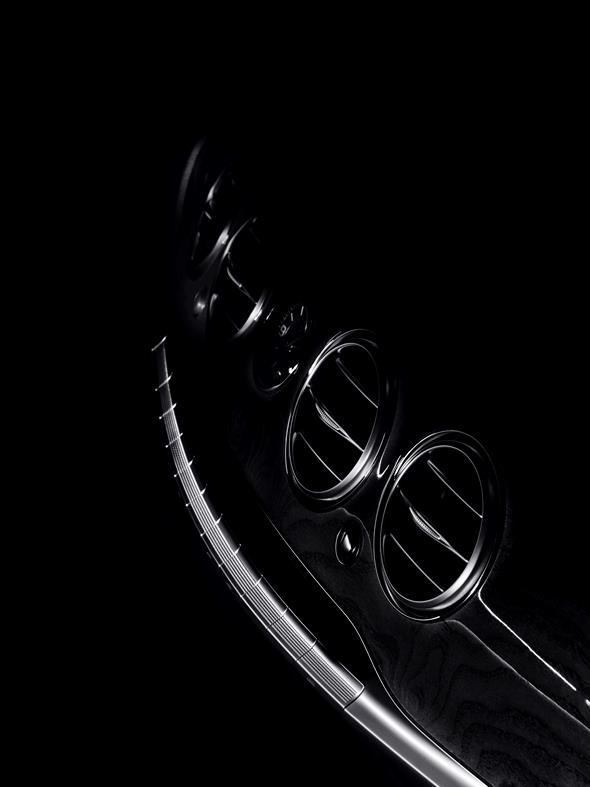
The seat developers paid particular attention to the rear seats. There is a choice of five different rear seat variants including an Executive seat with a backrest angle adjustable by up to 43.5 degrees, allowing occupants in the rear to concentrate on work or relax in comfort.
The occupants of the new S-Class benefit from the moderate increase in vehicle size by an improvement in all the interior dimensions: there are 12 millimetres more maximum headroom for the driver, as well as 14 millimetres more shoulder room and 10 millimetres more elbow room in the front.
Thanks to the 14-millimetre increase in rear kneeroom travel becomes even more comfortable for passengers in the rear. Shoulder room in the rear has been improved by up to 11 millimetres.
Intelligent lightweight construction and innovative functions: the front seats
Intelligent lightweight construction was the watchword during development of the seats. At less than 20 kilograms, the structure of a front seat weighs around 20 percent less than conventional designs.
This is in large measure due to the sandwich construction of the side sections on the seat frame, which consist of a two-piece, high-strength steel shell with integrated plastic inserts.
This enables the forces from the backrest attachments to be symmetrically introduced into the seat base.
There is a further advantage for the seat belt system: unlike with other seat structures, the belt buckle and anchor fitting not only move with any fore-aft adjustment, but also with seat height adjustment.
Whatever the size of the seat occupant, this always ensures the best possible belt fit and maximum safety.
The front seats of the new S-Class are electrically adjustable for length, height, inclination and seat cushion depth.
The 4-way Power lumbar support and head restraint height can be equally conveniently adjusted at the touch of a button.
If the Memory package for the driver and front passenger is specified, the front passenger seat can also be adjusted by the driver if required.
Thanks to wide-ranging adjustments, occupants of very different sizes are seated very comfortably in the new S-Class. The figures:
- Fore-and-aft adjustment: 290 millimetres
- Seat height: 65 millimetres
- Seat cushion depth: 65 millimetres
- Head restraint height: 60 millimetres
- Cushion angle: +/- 2.5 degrees
- Backrest angle: 27 degrees forward, rearward inclination limited by characteristic mapping to prevent collision with the luxury seats
in the rear
The sophisticated upholstery structure of the front seat backrests includes Pullmaflex springing and a natural fibre/rubberised hair insert lined with cut foam.
In the seat cushion, the flat spring core of the cushion base has a contoured foam insert lined with cut foam. In each case the seat cover has a fleece lining.
The front head restraints are adjustable both vertically and horizontally. Optionally available electric horizontal adjustment (EASY ADJUST luxury head restraint) is new in the S-Class, and optimises the distance between the occupant’s head and the head restraint to lower the risk of whiplash injuries.
Numerous innovative features enhance both seating and climatic comfort – an overview of the most important new developments:
The Front Seat Comfort package includes a world first in the form of the ENERGIZING massage function on the hot-stone principle.
In collaboration with physiotherapists and psychologists, the seating experts at Mercedes-Benz have developed a unique massage system with 14 separately actuated air chambers in the backrest and an integrated warming function.
There is a choice of six massage programmes, two of which are heat-assisted (for details see section “Under the microscope”).
In addition the Front Seat Comfort package includes active-multicontour seats with further improved dynamic functions, which have been awarded a seal of approval by EGR, an organisation promoting spinal health.
There is yet another debut within the Seat Climatisation package: for the first time, so-called reversing fans are used in the active seat ventilation system.
Here the rotational direction of the fan, and therefore the airflow within the seat structure, can be reversed.
When the ventilation function first begins, cooler surrounding air is drawn onto the seat surface.
This enables the surface temperature of a heated-up seat to be reduced much faster than with the previous active cooling systems.
After four minutes the fans are automatically switched to blower mode to reduce draughts and therefore ensure sustained comfort.
Together with the perforated leather, four fans in the seat cushion and two fans in the backrest ensure a uniform relative air humidity where the occupant’s body meets the seat.
The intensity can be adjusted in three stages according to individual requirements.
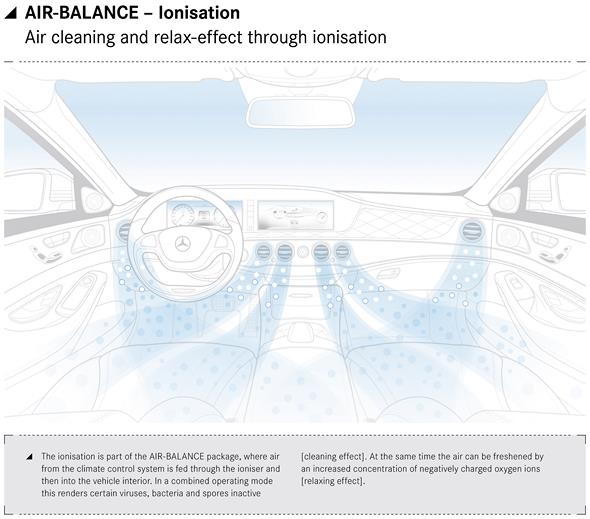
In combination with seat heating – which is also part of the “Seat Climatisation” package but can be ordered separately in conjunction with leather seats – each occupant is able to find the ideal climatic seating comfort.
Using the head unit, the customer is able to select the heating output for himself and activate the fast-action heating function.
In the main seat area this provides a heating output of up to 2000 watts per sq. m.
The “EASY ADJUST luxury head restraint” adjusts itself automatically when the backrest position of the driver or front passenger seat is changed. This keeps the distance between the head and the restraint constant.
On the front passenger side the head restraint can be folded down or removed, allowing the rear passenger an unobstructed view to the front.
If the S-Class is ordered with the “Chauffeur package”, the rear seat occupant on the front passenger side has 77 millimetres more maximum kneeroom.
This is because the front passenger seat can be moved 40 millimetres further forward, and a further 37 millimetres are available thanks to a 4-link system.
In addition to this “chauffeur position” the front passenger seat can be folded forward or placed in an extended-recline position (for details see next section “The rear seats”).
The “EASY ADJUST luxury head restraint” is standard equipment with the “Chauffeur package”, as is a heel support for the rear passenger which extends from under the front passenger seat if the long-wheelbase version is ordered.
Luxury and reclining seat on request: the rear seats
Whereas in Europe and North America the owner of an S-Class is frequently behind the wheel themself, the flagship model in the Mercedes-Benz passenger portfolio is very definitely a chauffeur-driven vehicle in Asia.
The logical consequence is the particular attention devoted to the rear by the seat developers. The rear seats are therefore right in the forefront when it comes to seating/climatic comfort and passive safety.
Two rear seat variants (static bench seat or individual seats with 37-degree adjustment) are available for the standard-wheelbase S-Class and no less than five for the long-wheelbase version– see table on next page.
The adjustment kinematics have been changed in the luxury and reclining seat variants. Unlike the conventional trailing backrest design, the backrest is adjusted separately so that the legroom and seat reference point remain unchanged. The cushion can be separately adjusted for angle and horizontal position.
The maximum backrest angle of the Executive (reclining) seat on the front passenger side is increased from 37 to 43.5 degrees, giving it the largest backrest inclination in the luxury segment.
The reclining seat behind the front passenger seat features a calf support which is freely adjustable for length and angle.
In combination with the heel rest on the folding chauffeur seat (see section “Front seats”), this allows a reclined position that sets new standards in the automobile sector with respect to sleeping and resting comfort.
The individual seat functions in the rear, and those of the chauffeur seat, are operated via the typical Mercedes control panels in the rear doors.
The “resting position” key is pressed to bring the front passenger seat and rear seat into the reclining position.
The most upright backrest position of 19 degrees in the luxury and reclining seat variants allows relaxed working in the rear.
The rear seat variants at a glance:
| Rear seat variants | Basic version | Long version | |
| Bench seat with 27° backrest angle | three-seater bench seat with folding centre armrest | standard | standard |
| Luxury seat with 19 to 37° backrest angle* | three-seater with individual outer seats and folding centre armrest | optional | optional |
| two-seater with Business centre console in the rear | – | optional | |
| Executive (reclining) seat with 19 to (on the front passenger side) 43.5° backrest angle* | three-seater with individual outer seats and folding centre armrest, additional cushion for luxury head restraint | – | optional |
| two-seater with Business centre console in the rear, additional cushion for luxury head restraint | – | optional | |
*Variably electrically adjustable, S = Standard, SA = Optional extra
If the First Class Rear is specified (with rear centre console), the front console on the transmission tunnel is visually continued to the rear.
It is equipped with innovative thermo-cupholders which use Peltier technology to cool or warm drinks over a longer period of time.
Like an aircraft seat, the centre console is available with two tables which can be easily folded in or out using one hand. Two articulated joints on the stem and underside of the table enable it to be adjusted to almost any position.
The table supports and surface are of light alloy, combining great stability with a high-quality look. The table surfaces have leather inserts to provide a comfortable writing surface.
The optional “Rear Seat Comfort package” also makes the innovative ENERGIZING massage function on the hot-stone principle available for the rear seats. The package also includes multicontour seats in the rear (without dynamic control function).
Setting the standard for safety in the rear: new features in the S-Class
Mercedes-Benz has extended the safety system for rear seat passengers further with the belt buckle feeder, the beltbag and the cushionbag. The first two of these developments are included in the “Rear PRE-SAFE® package”.
With the belt buckle feeder, an electric motor extends and retracts the belt buckle automatically.
In this way, any belt slack in the area of the pelvis and thorax can be reduced so that passengers are secured more firmly in both the sideways and the lengthways direction.
Fastening seat belts in the rear has also been made simpler: the seat belt buckle emerges from the upholstery when the rear doors are opened and is provided with an illuminated insertion slot.
Making the belt-fastening procedure easier may lead to increased use of rear seat belts.
The beltbag is an inflatable seat belt strap which can lower the risk of injury to rear passengers during a frontal impact by reducing the loads acting on the ribcage.
Should the crash sensors detect a severe frontal impact, the airbag control unit will trigger deployment and inflation of the beltbag.
A gas generator then inflates the multi-layered belt strap with Velcro seams to nearly three times its normal width.
The resulting larger surface area is able to better distribute the force acting on the seat occupant, thereby reducing the risk of injury.
The reclining seat is equipped with a cushionbag as standard. This has enabled Mercedes-Benz to design a comfortable reclining seat which provides a higher level of accident safety than a seat with a trailing backrest.
The airbag is located under the seat cushion upholstery, but on top of the plastic seat shell, which is moved by the seat mechanisms.
This means that the airbag is always in the same position on the seat shell, and therefore relative to the pelvis position of the occupant.
In an accident, with the occupant in a reclined position on a flat seat cushion, there would otherwise be a danger of the pelvic area sliding beneath the seat belt (so-called submarining).
This can be prevented by the cushionbag, as it raises the front section of the seat cushion upholstery.
The airbag is only activated if the seat is in the reclined position during a crash. It is not activated in the upright position, as there is then no danger of submarining because of the seat cushion angle.
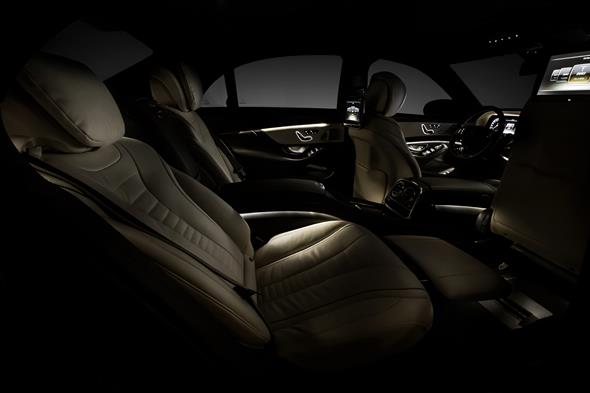
The seats actively keep the passengers fit
Under the microscope: ENERGIZING massage function on the hot-stone principle
The numerous world firsts in the S-Class include the ENERGIZING massage function on the hot-stone principle.
Combining warmth with a massage leads to wellbeing and active relaxation – especially on long journeys.
In addition there are programmes to mobilise and activate the torso (abdominal and back muscles).
Thomas Geisel, who is responsible for S-Class seat development at Mercedes-Benz: “The car seat has by no means reached the end of its development.”
Massage on the hot-stone principle is a widespread tradition found on every continent, and has been developed further in recent years to enhance relaxation and wellbeing.
With this technique, the spine is covered with stones heated to up to 55 degrees C and massaged. In 2007 developers at Mercedes-Benz began to consider how this technique might be applied to car seat functions.
Daimler employee Dr. Gudrun Schönherr, a physiotherapist and psychologist, explains: “Sitting in a car in a position imposing sternocostal stresses (i.e. with the back arched) often leads to tension in the neck/shoulder area, a constrained chest cavity and therefore less freedom to breathe.”
The innovative solution arrived at by the seat specialists and Dr. Schönherr is the pneumatic 14-cell massage mat, which is based on the massage function already available previously.
Each air chamber can be individually inflated, which allows considerably more scope when configuring the massage programmes.
The four cells in the middle act in combination with a fast-action seat heating function. In the Hot Relaxing Massage Back and Hot Relaxing Massage Shoulder programmes of the ENERGIZING massage function, a defined amount of heat is applied.
How the hot-stone principle is applied
Following a pre-massage, heat is centrally and locally applied along the entire spine from the coccyx to the neck vertebrae. The centre chambers are fully inflated with air.
Thanks to this pressure the warmth from the seat heating Plus function is perceived very intensively — feeling similar to successively laid-down, heated stones on the hot-stone principle.
While the heat and pressure of the “hot stones” are taking effect, the back, pelvis and shoulder areas are massaged and mobilised. To this end a row of five air chambers is arranged to the left and right of the central cells. Each chamber can be separately actuated.
The occupants of the four seats in the new S-Class available with the ENERGIZING massage function have an individual choice of six programmes.
These differ in their massage sequence (the sequence in which the cells are inflated), speed and therefore effect.
There is also a choice of “weak” or “strong” intensity settings for each programme. Depending on the actuation mode the massage takes the form of double waves, strokes and percussion, based on kneading movements, pressure point massage and classic massage holds.
Two of the six programmes also offer the addition of heat on the hot-stone principle. The programmes of the ENERGIZING massage function have a duration of 12 to 15 minutes.
The six programmes of the ENERGIZING massage function:
1) Hot Relaxing Massage Back
2) Hot Relaxing Massage Shoulder
3) Activating Massage
4) Classic Massage
5) Mobilizing Massage
6) Active Workout
Depending on the programme, the warmth, massage and mobilisation of the spine relieve the shoulder/neck muscles and vertebral discs of stress, manipulating the spine in the chest and lumbar areas.
Tests with volunteers have shown that there is a particularly active workout in programme 6 thanks to activation of the torso muscles.
One challenge during the realisation of the ENERGIZING massage function was to develop the pneumatic system, whose pump must not only be powerful for the available installation space, but also quiet and very durable. Individual inflation and deflation of the 14 air chambers is controlled by solenoid valves.

Like the lumbar support, multicontour and dynamic functions of the seat, the ENERGIZING massage function is controlled via COMAND Online.
A function key in the centre console gives direct access to the control menu for the seat functions.
The Mercedes-Benz active multicontour seat (multicontour, massage function and dynamic adaptation) has the EGR seal of approval.
Under the microscope: seat production
In-house seat production to the highest quality standards
Mercedes-Benz is one of the few car manufacturers not to have the seats produced by a supplier, rather producing them in-house for the E and S‑Class.
“If we want to have top quality and durability, and at the same time lead the field in new functions such as the ENERGIZING massage function on the hot-stone principle, we must also have the necessary production know-how,” says Henry Wunderlich.
The 49 year-old is the production manager for Daimler seat manufacture in Böblingen, near Stuttgart.
This is where around 600 employees produce the seats for the E and S-Class on a two-shift basis. This is no easy task in view of the enormous variation, for in the case of the E-Class, customers around the world are able to order around 360,000 seat variants.
The new S-Class even exceeds this number of available variants by a wide margin. Hardly one S-Class seat is like another, thanks to the wide range of leather and colour combinations, numerous seat models, varying features and country-specific differences.
The production of seating systems is a sophisticated and demanding combination of skilled craftsmanship and the very latest production technology.
This is shown, for example, by the great care taken when fastening the seat covers, which are also hand-sewn in the case of “designo” upholstery.
Thin metal rods are inserted into special tabs in the seat cover, then clipped in place on the seat structure. This creates the contouring typical of Mercedes, combined with a positive climatic effect and outstanding comfort.
“Not everybody can do this,” says Wunderlich, and points out that the job profile has changed considerably: “We used to employ mainly upholsterers, but the job description nowadays is ‘specialist in automotive interior equipment’.
This is because the number of electronic and pneumatic components in seats has increased enormously in recent years, requiring the appropriate specialist knowledge in production.”
The electronic components include the restraint systems, the electric seat adjustments and other comfort functions such as seat heating, dynamic multicontour seat or the massage and heating elements.
The shopfloor is earthed, and for quality reasons the personnel wear anti-static working shoes.
The overall impression of modern seat manufacture is that of car production in miniature: the seats are not assembled in production bays as previously, but rather “just in sequence” as a line operation.
At the four production lines for the S-Class — two for front seats (right- and left-hand drive versions) and two for rear seats (cushion and backrest lines) — there are circulating tables that are movable and ergonomically adjustable.
At various stations the personnel complete the seats on these tables.
Hydraulic carriers and height-adjustable assembly facilities assist the process, and several changes of station per shift to avoid monotony is a matter of course.
The tightening torque for the bolts of the sidebag is even recorded electronically: “This means that even years later, we can show that the seat left here in perfect condition,” says Wunderlich.
During the final inspection at the end of the line, the seats must show that they meet the highest visual expectations and that all the functions work perfectly. When the seats finally leave the line, they have passed though up to 50 stations.
On the loading conveyor belt in the middle of the assembly shop, the front and rear seats are “married together” and loaded onto transport pallets, so that they can be delivered to the S-Class production lines just in time and in first-class quality.
Many new features for a pleasant atmosphereClimate control
During the systematic further development of the entire climatic system, a particular focus was placed on the development goals of performance, air quality, precise regulation, noise level and efficiency.
As a new feature, the AIR-BALANCE package comprises perfume atomisation, ionisation and even more efficient filtration compared to the standard model.
The THERMOTRONIC automatic climate control in the rear has two additional zones to improve thermal comfort.
Electric heating of the armrests, is a completely new feature.
The newly developed climate control unit of the THERMOTRONIC automatic climate control included as standard has a mass flow regulating concept whose automatic operating principle meets individual comfort requirements for every occupant.
New features include completely autonomous adjustment options for the driver and front passenger sides with respect to temperature level, air distribution and air volume, for the front footwell temperature with a warmer or cooler tendency and also for the individual automatic modes with their climatic settings of “Focus”, “Medium” and “Diffuse”.
The profiles, which differ in air volume and air distribution, can be conveniently set via the COMAND Online system.
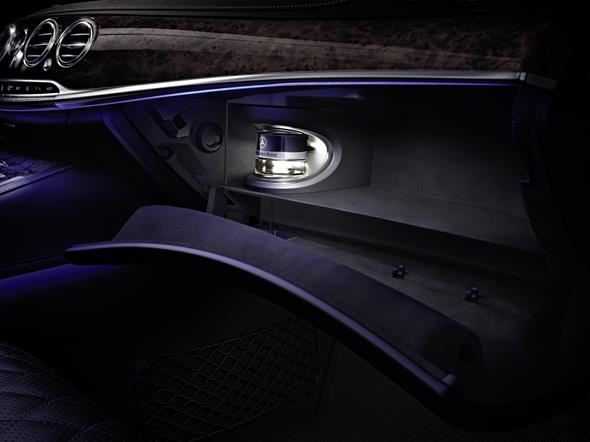
The AIR-BALANCE package: perfuming, ionisation and improved filtration
As a world first, the new S-Class Saloon has an “active perfuming system” as part of the AIR-BALANCE package.
‘Active’ means that the perfuming system is switched on and off manually, with manual adjustment of the intensity. The perfuming system has various operating modes:
- On/Off
- Intensity control “low – medium – high”
- Perfume selection by exchanging the flask in the fragrance generator
A high-quality fragrance introduced into an already luxurious interior like a perfume enhances the sensual impression of the Mercedes-Benz interior by appealing to the sense of smell.
In all advanced cultures, high-quality fragrances are part of the repertoire of sensual pleasure and individuality. Perfuming individualises the smell of the interior.
The interior smell is not changed permanently, nor are the perfume molecules deposited on fabric surfaces or clothing. The fragrance is discreet and mild, and dissipates rapidly.
Four interior fragrances (FREESIDE MOOD, NIGHTLIFE MOOD, DOWNTOWN MOOD, SPORTS MOOD) are available in attractively designed flasks.
The fragrances were developed in collaboration with the perfume specialist Marc vom Ende (see “Under the microscope”).
The perfuming system consists of two parts: a glass flask with an atomiser head and the fragrance generator in the glove compartment. The system uses the effect whereby there is a constant exchange of matter on the surface of a solution.
In the process, molecules enter the gaseous phase (volatilisation) while other molecules are returned to the liquid. If a partial airflow is passed over the surface of the liquid, the air can be enriched with the molecules of the chosen fragrance.
The perfumed air is then passed directly into the vehicle interior via a separate aperture. A bypass system allows the flow rate per unit of time to be variably adjusted.
This active perfuming system is a further development of the fragrance ball familiar from the MAYBACH ZEPPELIN.
Air filtering: fresh air for a fresh interior
Another component of the AIR-BALANCE package is filtering of the outside air fed into the vehicle interior by the climate control system, and of the air recirculating in the interior in air recirculation mode.
The filter system is now even more efficient, and is able to reduce the peak levels of certain gaseous emissions while lowering their concentration below the perception threshold.
The filter system consists of two combined fine dust/activated charcoal filters between the intake and air distribution system of the air conditioner.
Activated charcoal is used as the filter material for the interior by virtue of its good ability to absorb gaseous pollutants and odours. It is produced from coconut shells.
The sophisticated pollen filter technology in the fine dust filter component is particularly useful for allergy sufferers.
At Mercedes-Benz these filters are examined for effectiveness in both new and used condition, to ensure that their filtering efficiency is maintained at least until the next vehicle service.
Ionisation is another component of the AIR-BALANCE package, the air from the climate control unit being conducted into the interior via an ioniser. In a combined operating mode this renders certain viruses, bacteria and spores inactive (cleaning effect).
At the same time the air can be freshened by an increased concentration of negatively charged oxygen ions (relaxing effect).
Warmth Comfort package: heated armrests and seat heating Plus
The new S-Class Saloon is available with the optional Warmth Comfort package for all engine variants. This includes
- heated front armrests (door and centre armrests)
- fast-action seat heating Plus for driver and front passenger
- heated steering wheel
- heated rear armrests (door and centre armrests)
- Seat heating Plus in the rear
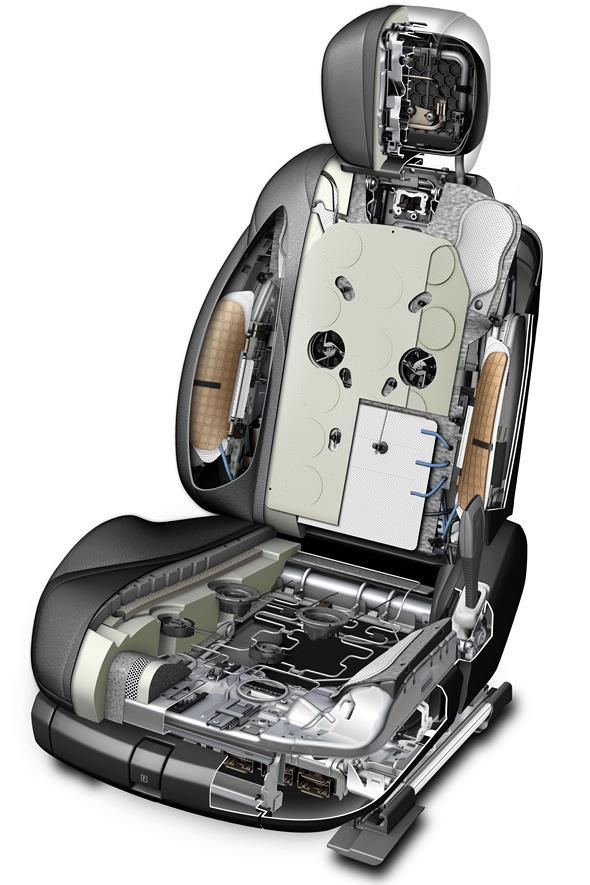
The innovation in this package is the armrests, whose surfaces can be heated by heating elements on the same principle as seat heating.
Originally conceived for the energy-efficient heating of electric cars, this panel heating in the S-Class makes for a particularly cosy environment.
The armrest heating is switched on and off using the seat heating switch in the door panel, and can be deactivated via COMAND Online.
The heating output of seat heating Plus can reach up to 2000 watts per sq. m., and can already be felt in the sensitive lumbar area after ten seconds.
Climate control: multiple adjustments, high efficiency
The new climate control system in the new S-Class combines energy efficiency with comfortable temperatures on every seat, and sets new standards in terms of the adaptability of automatic operation to the individual wishes of the occupants.
The new automatic climate control is operated via:
- the newly developed control panel below the centre vent
- the climate menu in COMAND Online
- the rear control panel in the rear centre console (if the optional rear climate control is specified).
To improve climatic comfort in the rear even further, a newly developed, water-flow controlled two-zone THERMOTRONIC rear automatic climate control system installed in the centre console is available as an optional extra.
The air is taken into the interior of the centre console. The cooled air flows through a water-flow controlled heat exchanger, and is distributed to the separate left/right centre vents, the rear footwells and the vents in the B-pillars.
Air distribution to both sides is automatically controlled by four step motors.
The basic functions of the air conditioning, i.e. automatic operation, temperature adjustment, air volume, residual mode, recirculation, defrost and heated rear window can be directly controlled by buttons in the front control panel.
Other climatisation functions such the auxiliary heater, perfume atomisation, ionisation and footwell temperature can be accessed via the climate status display in the head unit, where the air distribution and ventilation modes are also accessible.
The air volume and distribution control have been developed further and improved in comparison to the climate control system in the preceding series. This means:
- Automatic modes “Medium” (comparable to the same mode in the previous model), “Diffuse” (for the lowest possible airflow, and not aimed directly at the occupants; most of the air flows into the interior from the defrosting and footwell vents) and “Focus” (a higher volume of air mainly from the ventilation vents)
- Separately adjustable fans for the driver and front passenger
- Front footwell temperature can be individually made warmer or cooler in five stages, and separately for the driver and front passenger.
The heat exchanger in the heating circuit has an output of 9.7 kW at an air volume of 8 kg/min. Diesel models are equipped with a heat exchanger featuring three integrated PTC heating element rows with a selectable six-stage heating output of 1.5 kW.
An electronically commutated auxiliary water pump allows residual heat operation when the ignition is switched off. The flat-tube evaporator in the refrigerant circuit has an output of 8.8 kW.
In non-hybrid models the refrigerant compressor is variably externally controlled, and incorporated into the belt drive system via a magnetic coupling.
A large number of sensors are used to regulate the automatic climate control, e.g. venting and evaporation sensors, potentiometers in the vent selector wheels, multifunction sensor with moisture measuring cell and a ventilated interior sensor for the interior temperature in the area of the overhead control panel.
Solar radiation is registered with the help of two separate solar sensors on the left/right of the interior, a sensor in the cockpit and a sensor on the parcel shelf. GPS navigation data are used to determine the direction of the sun and the altitude above sea level (elevation).
In case GPS navigation data are not available, a fallback calculation of the sun’s direction is made on the basis of the vehicle-encoded country of delivery, the time of day and the date.
The air conditioning control system is then able to respond to a heat build-up caused by direct solar radiation, even when the solar sensors have not yet registered any change in the interior, e.g. if it is wholly or partly shaded by the A/B/C-pillars or roof.
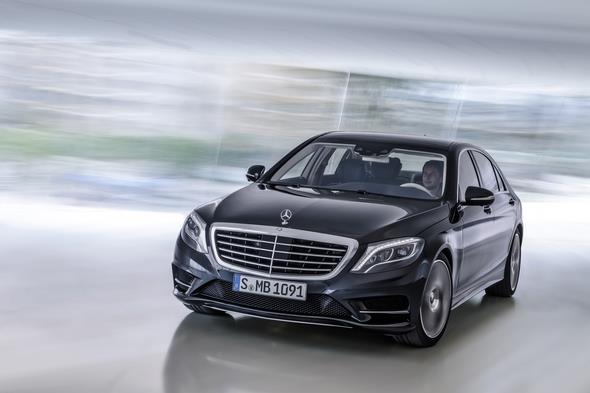
Energy-efficient climate control: economical heating and cooling
Various measures have been incorporated to make the climate control system as energy-efficient as possible.
- Energy-efficient control with variable evaporation temperature and misting sensor
- PWM (pulse width modulated) blower control unit
- Internal heat exchanger with efficient cooling circuit
- Externally controlled refrigerant compressor with magnetic coupling (non-hybrid models) and internal oil separator
- Electronically controlled refrigerant compressor which can be operated within the most efficient range, whatever the engine speed
- Maximum heating combustion as efficient auxiliary heating for diesel models
- Green-tinted thermal insulation glass all-round as standard
- Optional extra: thermally and noise-insulated, infrared-reflecting laminated safety glass all-round
- Efficient surface heating as an optional extra
- Thermal insulation of the interior in combination with NVH measures.
As an optional extra, an auxiliary heater with radio remote control is available as part of the climate control system.
In this way the interior of the parked vehicle can be heated or ventilated with fresh air, with activation as follows:
- Control panel in the vehicle
- Preset function using COMAND Online and the central control panel. The activation time is calculated automatically as a function of the vehicle’s external and internal temperature
- Radio remote control with acknowledgement of successful transmission, also display of the remaining heating or ventilating time.
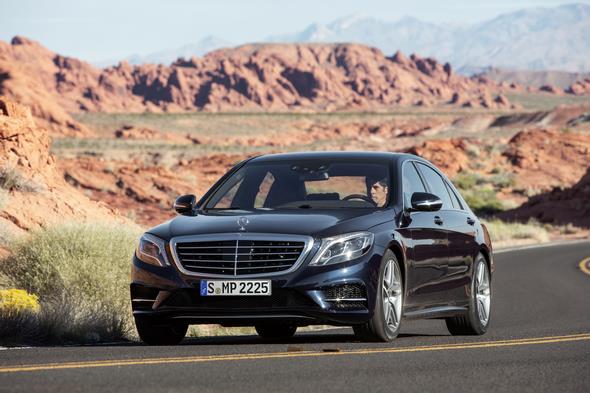
The fourth dimension of sensuality
Under the microscope: Interview with Marc vom Ende
Marc vom Ende developed the fragrances for the new perfume atomisation system in the S-Class.
The 44 year-old is a senior perfume specialist for the fragrance manufacturer Symrise in Lower Saxony, heads its perfumery school and is a member of the jury for the innovation awards of the German perfumery retailers association.
We spoke to him about his creations for Mercedes-Benz.
Mr vom Ende, you have already created world-famous perfumes such as “IcebergHomme” or “Alain Delon”. Was it a particular challenge to create fragrances for a vehicle this time, for the new S-Class?
When I apply a body perfume I am expressing my personality and the mood I happen to be in.
The requirement is similar for the interior smell of the S-Class: here too we should reflect the character of the individual driving the car, and also the atmosphere of the car itself.
It was fundamentally important to me that the fragrances reflect certain personalities and characters.
I did not want bland fragrances without a clear profile, but rather distinctive fragrances as an expression of a distinctive personality – in keeping with the ideals of the Mercedes-Benz brand.
How does a perfumery expert tackle this task, how were the perfume compositions for Mercedes-Benz created?
We always work with images that inspire us, and which we try to recreate with fragrances. As perfumers we know the entire range of available raw materials, and experience tells us which combinations lead to what results, creating certain harmonies. We gradually approach this ideal image.
When I started the development work I paid a visit to the interior designers in Sindelfingen. We had a very interesting exchange of views which caused me to deviate from the approach I had envisaged.
Originally I wanted to work with the smell of leather, but then realised that the car itself smells of leather, and that my fragrances must go hand in hand with this.
A visit to the research workshops allowed me to see the brand from a completely different point of view, and gave me new ideas for suitable fragrances.
The presentation of the F800, for example, inspired me to create the perfume DOWNTOWN MOOD. The car is so delicate in structure, so light and airy, and I went home with the idea of this perfume in my mind.
So when creating the perfumes you took your inspiration from the interior of the S‑Class?
Yes, I already got to know the S-Class during an early development phase. But far more important to me was the brand itself and the working approach of the designers.
I was very impressed with the care taken when selecting the individual materials and colour combinations. This gave me a new stimulus and point of view for my own assignment.
Have you had an opportunity to experience the perfume atomiser in the new S‑Class ‘live’?
Yes, I was able to test the perfume atomiser in an S-Class, and during the creative work I also had a portable atomiser available.
Being able to test the perfume atomiser was extremely important to ensure that the intensity of the fragrance is at the right level.
We initially work with strips of paper, but the result produced by the technology used in the S-Class is different. In this case the perfume reveals its entire sensuality.
Could you briefly characterise the four S-Class fragrances – FREESIDE MOOD, DOWNTOWN MOOD, SPORTS MOOD and NIGHTLIFE MOOD?
Lightness predominates in FREESIDE MOOD, with pleasant, high-quality citrus touches. The fragrance is very balanced without excessive nuances, and therefore does not polarise opinion.
It is unobtrusive yet present. DOWNTOWN MOOD outstandingly suits the interior, and has a floweriness with a subdued metallic effect.
Warm, musky nuances make the fragrance sexy, and thanks to a touch of powdery sensuousness, it is the most feminine of all the perfumes.
After a while the fragrance has a very atmospheric effect on the interior, without really being prominent.
During the test drives I absolutely fell in love with this fragrance. SPORTS MOOD enlivens with a pleasant, natural freshness reminiscent of young light-green leaves, rounded off with slightly flowery nuances.
And right from the start, NIGHTLIFE MOOD reminds one of opening a box of expensive cigars bedded in an aroma of warm, luxurious wood.
A touch of ambergris accentuates the high quality of this fragrance. I associate NIGHTLIFE MOOD with the image of a heavy leather armchair in front of the fire in a room panelled with exotic wood, a glass of brandy on the side table (lending a fruity touch) and a cigar.
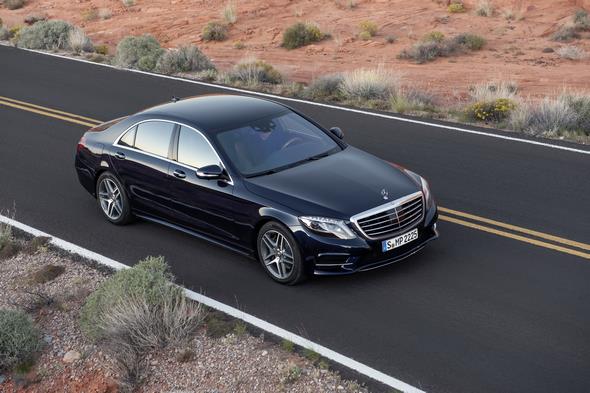
Under the microscope: actuators make the S-Class more comfortable
More than 100 little helpers
The new S-Class features highly sophisticated, automatic climate control functions. The seats likewise lay claim to being the benchmark in automobile engineering.
In both cases this is accompanied by maximum operating convenience, ensured by numerous actuators and electric motors – there are over 100 of these in the interior alone.
In the fan filter tract of the air conditioning unit the air is taken in by a blower consisting of a twin-shaft motor and two impellers.
The temperatures in the four air mixing chambers are regulated to the desired vent temperatures by the use of mechanically coupled cooling and warming flaps.
A total of 14 step motors control the flaps of the mixing zones and air vents, and three step motors (four if the optional THERMOTRONIC rear automatic climate control is specified) control the flaps in the air ducts to the side vents and rear centre vent.
There is also a step motor in each of the two air deflectors in the rear footwell. Plus there is the rear fan and a fan for the temperature sensor, making a maximum total of 21 motors.
With full specifications, up to nine seat adjustment motors bring each of the front seats and EASY ADJUST luxury head restraints into position.
There are also six seat ventilation motors. In the rear there are up to twelve motors for each seat.
This means that in an S-Class, 54 actuators take care of occupant seating comfort, while two more move the steering wheel to the desired position.
There are also 14 pneumatic massage cells per seat, each of them activated by solenoid valves.
Other motorised helpers:
- Four power window motors
- Five motors controlling exterior mirror adjustment, folding and the parking position for the front passenger mirror
- Five motors for silent closing of the doors and boot lid
- Two motors move the tweeters in the mirror triangles if the Burmester® High-End 3D Surround Sound system is ordered (incidentally this has 24 speakers)
- A vibrating unit in the steering wheel in conjunction with Active Lane Keeping Assist
- A fan motor for the central display
- Two motors powering the panoramic sliding sunroof and sunblind
- Three motors powering the electric sunblind for the rear window and those in the rear doors
- Two motors for the rear belt feeders, two motors for the reversible belt tensioning in the front
- Two motors for the DVD players.

Communication centre and concert hall
Multimedia features
A completely new multimedia generation with intuitive operation and particularly tangible functions thanks to visualisation and animations celebrates its debut in the S-Class.
Other innovations include the multi-user system, which allows independent access to the media sources of the entertainment system from any seat.
The new S-Class is also the first saloon car to be equipped with the unique Frontbass system as standard.
In this system, the interior space in the bodyshell’s cross-members and side members is used as a resonance chamber for the woofers.
A 3D surround sound system is available on request.
Several hundred developers worldwide contributed to the new Mercedes-Benz multimedia generation, compiling more than 30 million lines of programming.
The centrepiece of the new COMAND Online is the Intel Atom, a processor whose performance fully equals that of components in the latest laptops.
As a completely new feature, the developers have made the individual functions of the communication systems more tangible with on-screen visualisation and animations (see section “Operation”).
The user is also able to adapt what is shown in the central display to their own requirements.
With the exception of the navigation map (which always fills the complete display area), the central display is divided into a main area (2/3 on the right of the screen) and an additional area (1/3 on the left side of the screen).
In standard configuration the additional area shows supplementary information about the selected main application, e.g. if the radio function is active, the artist and song title are shown, or the current channel in the case of TV.
It is also possible to permanently show preferred contents in the additional area (except when the full navigation map is active).
It is possible to select a small navigation map, fuel consumption display, data connection display or entertainment information, for example.
In addition to this improvement in operating convenience, numerous new functions extend the multimedia options available, and transform the S-Class into a communication centre or a concert hall as required.
The interactive presentation of content is a prominent new feature of the navigation function.
The new navitainment functions include an animated compass, the “Driveshow” for passenger information as in an aircraft, and the display of Google Maps on the head unit and in the rear.
Information on the traffic situation is shown with hatched lines (rather than with vehicle silhouettes as before).
Thanks to real-time traffic information, the navigation system is also better informed about the situation on the roads.
Traffic data are now provided by the “Live Traffic Information” service.
Unlike the previous data sources TMC and TMCpro, whose data are received by radio, “Live Traffic Information” uses a fast internet connection and is therefore particularly up-to-date.
As another new feature, a key word search can be used to enter destinations: only a few letters need to be entered, and the system will automatically display a choice of appropriate town/street combinations and possible points of interest. The letter combinations or key words can even contain spelling mistakes.
Example: if the driver enters STUT and BAD, the system will suggest ‘Stuttgarter Strasse’ in Bad Friedrichshall, ‘Badstrasse’ in Stuttgart and the ‘Freibad Möhringen’ swimming pool in Stuttgart.
The entered key words are visually highlighted in the display of search results.
In the radio function the favourite stations can now be saved to an individually organised preset list for all wavebands (DAB, FM, AM) rather than to a general autostore function. Individual stations can then be called up using the favourites function.
The “song tagging” function is likewise useful: songs just played in the vehicle can be flagged and then downloaded to a mobile device via iTunes and the internet connection.
The player is now able to recognise mixed tracks, i.e. video and audio files. Videos are shown as a preview in a small, animated area, and can be enlarged to full-screen format.
The function “Play similar titles” suggests songs similar to the one currently playing, accessing the CD, Music Register or a connected source.
Also new are the Coverflow display, the album cover search and the Picture Viewer as a slideshow.
The telephone module with Bluetooth® is standard equipment with COMAND Online. This supports the connection of the mobile phone to the vehicle via a standardised Bluetooth® interface.
In addition “Convenience telephony” can be ordered as an optional extra by way of a pre-installation using a universal phone interface, whereby the mobile phone can be connected via a cradle in the centre console.
Suitable cradles for various mobile phones are obtainable from Mercedes-Benz Accessories.
“Business telephony in the rear” with a hands-free function is optionally available for passengers in the rear. Connection of the mobile phone to the rear unit is likewise via Bluetooth®.
Preinstallation with a universal phone interface is also possible for the rear. Telephony via COMAND Online is networked with the Business telephony in the rear.
Calls can therefore be conveniently transferred between the driver and the rear, and functions such as call waiting or conference are also available.
Business telephony is operated via a Bluetooth® handset integrated into the rear and featuring a convenient touch display. This allows functions such as seat adjustment to be operated intuitively.
The most important new functions at a glance:
| System | Functions |
| COMAND Online |
|
| Navigation |
|
| Radio |
|
| Player |
|
| Phone |
|

Equal rights for every occupant: the entertainment features
The new S-Class is the first vehicle worldwide to offer a genuine multi-user system with Individual Entertainment in the rear.
This means that there is independent access to the media sources of the entertainment system from any of the four seats – i.e. radio, TV, internet, navigation, DVD player and USB-connected devices.
The driver control function for all the seats is another new feature. The driver is able to route any audio or video source to the display and headset of any passenger.
At the touch of a button the driver is also able to have one of the audio sources in use played via the onboard loudspeakers.
The multi-user system was technically realised by connecting COMAND Online with the Individual Entertainment system in the rear via a fibre-optic cable, a so-called MOST bus system (Media Oriented Systems Transport).
Access to the sources from any seat is possible via the MOST ring, which works with a transfer rate of up to 150 Mbit per second.
For the COMAND remote control function, digital radio technology is used for the first time instead of infrared technology. This makes operation throughout the vehicle possible from any position.
The well-proven SPLITVIEW for the driver and front passenger has been retained. COMAND Online forms a mixed image from two separate display images (e.g. TV and navigation).
This is then separated in the high-resolution central display by means of prisms, enabling different screen content to be shown for the driver and front passenger depending on the viewing angle.
The driver and front passenger therefore see different images – the passenger can watch television while the driver is following the navigation instructions.
Together with the DVD changer, headset and COMAND Online remote control, SPLITVIEW is part of “Individual Entertainment”.
The “Rear Individual Entertainment package” comprises a second DVD player (in the centre console for the five-seater, in the parcel shelf for the four-seater), two high-resolution 10.2-inch displays, remote control and two wireless headsets.
With Frontbass and up to 24 loudspeakers: the sound systems
The innovative Frontbass system developed by Mercedes-Benz and used for the first time in a saloon car is a feature common to all the audio systems: the woofers are housed in the firewall, and use the almost 40-litre space in the cross-member and side member as a resonance chamber.
Conventional woofers in the doors are therefore unnecessary. The mid-range speakers in the doors are relocated upwards. This improves sound brilliance and allows additional stowage space in the doors.
As alternatives to the standard sound system with ten loudspeakers, two very high-quality audio systems are available which were developed together with the audio specialists at Burmester: Burmester® Surround Sound system and Burmester® High-End 3D Surround Sound system.
The features of the three sound systems at a glance:
| Standard sound system | Burmester® Surround Sound system | Burmester® High-End 3D Surround Sound system | |
| Loudspeakers (tweeters/mid-range/woofers/Frontbass/Bassbox) Total | 4/4/0/2/010 | 4/7/0/2/013 | 9/8/4/2/124 |
| Total loudspeaker output | 100 watts | 590 watts | 1540 watts |
| Additional amplifier | – | DSP (multi-channel) amplifier with nine active channels | 24-channel) amplifier, analogue diplexer, additional amplifier for Bassbox |
| Sound presets | Surround | Pure/Easy Listening/Live/Surround/3D Surround | |
| Specials | Volume control (GAL) | Front/rear sound optimisationVehicle noise compensation (VNC) | 3D Surround SoundVIP settingVehicle noise compensation (VNC) |
The systematic use of analogue diplexers in the medium and high frequency ranges ensures an extraordinarily expressive and natural sound. Bass, mid-range, treble, volume, balance and fader can be individually adjusted.
The listening experience can be enhanced even further with the Surround function or sound optimisation for the front and rear seats.
The Burmester® High-End 3D Surround Sound system makes for an outstanding listening experience, with the best possible sound settings for every seat and, for the first time, three-dimensional sound in a luxury saloon car.
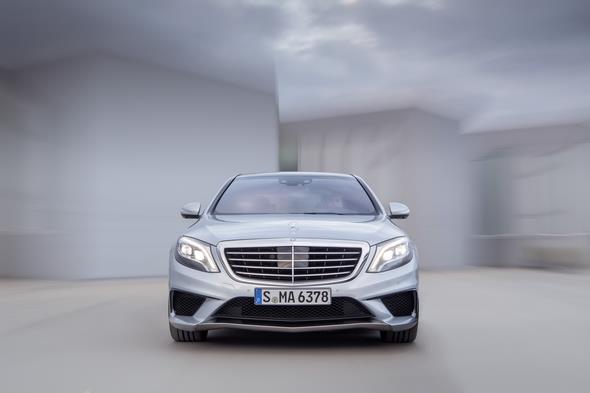
This 3D surround sound is created with the help of special Burmester algorithms and three speakers integrated into the headlining.
This system is visually distinguishable from the Burmester® Surround Sound system by these overhead speakers, door speaker covers and illuminated tweeters in the mirror triangles which extend electrically and light up in a choice of seven colour tones.
This combination of analogue and digital technologies produces an extraordinarily expressive and natural sound – the Burmester “feel-good sound”.
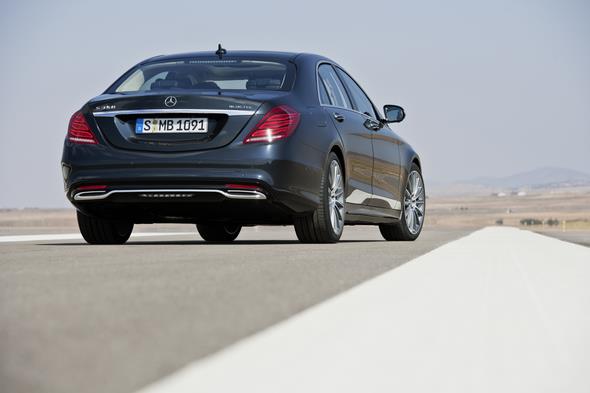
Three-dimensional sound in the car
Under the microscope: Burmester® High-End 3D Surround Sound system
The optional Burmester® High-End 3D Surround Sound system provides an outstanding visual and acoustic experience.
As a visual highlight, the tweeters in the mirror triangles of the front doors are particularly sophisticated.
When the head unit is switched on, they rotate by 360° and perform a screwing motion of ten millimetres towards the occupant. This ideally aligns the tweeters for an optimal sound impression.
If the ambience lighting is switched on, the two tweeters are illuminated in one of the seven available colours.
The same applies to the overhead console, which is also elegantly emphasised by the ambience lighting and accommodates two of the three overhead speakers.
The Burmester® High-End 3D Surround Sound system provides its unrivalled listening experience by virtue of 24 high-performance speakers and 24 separate amplifier channels with a total output of 1540 watts.
At the same time an intelligent combination of analogue and digital amplifier technologies leads to a particularly fine and natural sound together with high performance reserves.
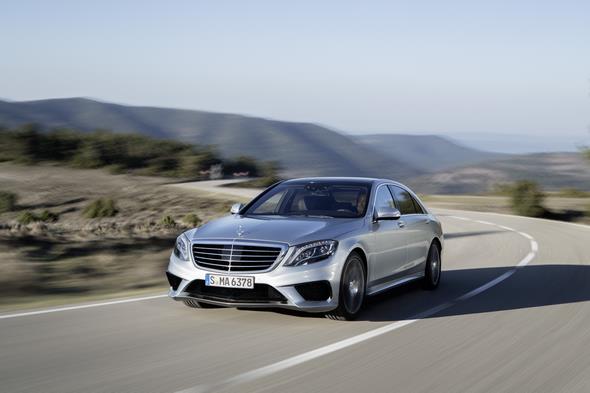
While sophisticated analogue filter settings allow the best possible fine reproduction in the mid-range and treble frequencies, the digital amplifier – despite its compact dimensions – masters the highest dynamic peaks.
The result is outstanding sound resolution and fine acoustic detail, combined with impressive impulse reproduction. This provides a rounded, warm and substantial sound experience founded on an impressive bass range.
The new, three-dimensional listening experience provided by the 3D-Sound system and created by the Burmester speakers integrated into the vehicle roof is unique.
In addition to the two speakers in the overhead console, another speaker is accommodated in the overhead control panel.
A 3D algorithm was developed specifically for the S-Class to create the unique listening experience made possible by these overhead speakers.
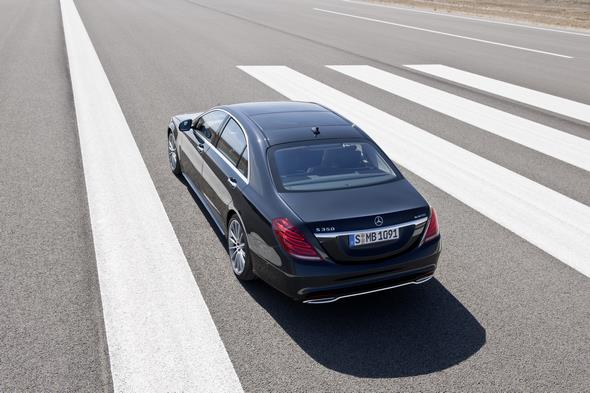
The aim of the developers was to add a subtle spatial effect to the outstanding listening experience.
Apart from 3D-Sound, four other preset sound modes can be selected to suit every taste and audio source:
- Pure: audiophile sound reproduction with no additional effects, for unadulterated musical enjoyment
- Live: appealing, dynamic sound background akin to live music
- Easy Listening: milder sound background for relaxed listening over longer periods
- Surround: virtual surround sound
- 3D-Sound: three-dimensional listening experience provided by the overhead loudspeakers
Using the so-called VIP setting, the sound quality can be optimised for any of the four seating positions. This function has been carefully configured for each of the sound modes shown above.
The sophisticated sound compensation (VNC) has also been developed further. This ensures that the best possible sound impression is maintained despite changes in driving noise.
VNC guarantees maximum listening pleasure at all times – whether on the motorway or in town.
Elegant new control centre
New control and display concept
Two high-resolution TFT colour displays in 8:3 format with a screen diagonal of 30.7 cm (12.3 inches) form the new information centre in the S‑Class.
The left-hand display performs the functions of the previous instrument cluster, providing the driver with all relevant information.
The right-hand display allows the convenient control of infotainment and comfort functions. Ergonomics, operating convenience and safety, as well as visual appeal and elegance, were the main considerations for the newly designed control and display concept.
For the S-Class, the constantly increasing need to integrate additional functions into the vehicle led to a further development of the entire operating logic.
The aim in designing the control and display features was to group controls and display functions together in a coherent manner in terms of both design and functionality.
Apart from the new displays, the metallised switch surfaces and solid aluminium controls are visual highlights of particularly high quality.
Thanks to the fine structuring on the metal surfaces, each individual control has the sound, feel and attention to detail that makes Mercedes-Benz something very special.
The well-proven Mercedes-Benz operating philosophy with a multifunction steering wheel, DIRECT SELECT selector lever and COMAND Controller in the centre console has been retained.

The engineers have, however, taken a new approach with the large high-resolution display depicting the instrument cluster, a display area showing the driving assistance systems next to the rotary light switch and a new position for the cruise control stalk, on the left below the combination switch for the wipers and indicators.
With Mercedes-Benz COMAND Online the customer is now able to adapt the contents of the central display to personal requirements.
With the exception of the navigation map (which always fills the complete display area), the central display is divided into a main area (2/3 on the right of the screen) and an additional area (1/3 on the left side of the screen).
In standard configuration the additional area shows supplementary information about the selected main application, e.g. if the radio function is active, the artist and song title are shown, or the current channel in the case of TV.
If required, it is also possible to permanently display a preferred content item in the additional area, for example a small navigation map, fuel consumption display, data connection display or entertainment information.
High-quality visualisation and animations make for convenient operation — changes in adjustments e.g. for the climate control or seats are immediately visible and therefore easy to follow.
The two screen displays have an illuminated “corona” for effect, making the display appear to be floating in space. This lighting can be individualised in seven colours as an option.
Like the switch and controls illumination, the brightness can be adjusted using a rotary control between the instrument cluster and central display.
Optionally, individual brightness levels can be set for the different lighting zones in the vehicle interior using the vehicle functions of the COMAND Online system.

The new instrument cluster: important information at a glance
The architecture of the instrument cluster in the S-Class is a new departure for Mercedes-Benz. For the first time a large TFT colour display with a screen diagonal of 30.7 cm (12 inches) in 8:3 format is used to display driver information.
The large screen provides much more scope with respect to the presentation of contents, animation of displays and vehicle-related information, especially where the onboard assistance functions are concerned.
The design of the two large dial instruments showing the vehicle speed (left) and rpm (right) follows the classic style.
The menu for “Journey”, “Navigation” and “Media” and the relevant sub-menus accessible between the two dial instruments are also familiar in principle, and are operated using the steering wheel function keys as before.
The central area between the dial instruments shows the driving assistance systems. When they intervene, the actions of systems such as DISTRONIC PLUS with Steer Assist, Active Blind Spot Assist and Active Lane Keeping Assist are notified to the driver by visualisation.
The image from Night&Day View Assist PLUS is now also shown between the two instruments, where it is easily visible. In the process the circular scales of the two displays are reduced to three-quarter circles with revised scaling to provide the largest possible area for the camera image.
In the central area of the display the driver also receives visual support when searching for a parking space.
Active Parking Assist with PARKTRONIC shows recognised parking spaces (left/right, parallel or end-on parking) and guides the driver through the parking procedure.
The graphics in this display resemble actual perspective views rather than two-dimensional images from above.
Recognised speed limits and any supplementary signs are now shown in the speedometer for easy visibility.
Mercedes customers will find the classic displays and warning lamps easy to recognise. The distance information for the front PARKTRONIC sensors (left/right) is shown at the top, between the two dial instruments.
Above this are the control lamps for the indicators/hazard warning system, lighting functions (parking lights, high beam, foglamps, low beam) and the distance warning.
The outside temperature is shown at the top centre. The fuel gauge showing the volume in percent is located in the speedometer (6 o’clock position), and the speedometer also accommodates the control lamps for the ESP® functions, ABS, the warning lamps for the airbags (SRS – Supplemental Restraint System), the seat belts and the tyre pressure monitoring system.
The coolant temperature appears in the 6 o’clock position in the rev counter, which also shows the current transmission mode, automatic transmission gear and the function displays for the electric parking brake, brake lining wear indicator and engine diagnosis.

Support for the driver: the ECO display
If required, three bar charts in the instrument cluster give the driver feedback about the economy of his driving style.
The ECO display responds positively if the driver accelerates moderately, drives smoothly in an anticipatory manner and avoids unnecessary braking.
The three bar readings stand at 100% if driving is particularly economical according to these criteria. When starting off all the values are at 50 percent, and a particularly unfavourable driving style causes them to decline.
The aim is to arouse a competitive desire in the driver to achieve 100 percent if possible.
The central display: the control centre for infotainment and comfort
A completely newly developed COMAND Online generation has its world premiere in the new S-Class.
It excels with intuitive operation and the immediacy of its functions, thanks to animated menus and images on a large display in 8:3 format with a resolution of 1440 x 540 pixels.
For video and TV reproduction a part of the screen corresponding to the 16:9 format is used.
The large display is used for animations and 3D effects. An additional area on the display simplifies operation with a context-related representation of the current application or permanent display of the navigation map, for example, or – in the case of models with hybrid drive – a display of the hybrid functions showing the energy flow.
The animated high-resolution display concept is particularly impressive where the digital operating instructions for COMAND Online are concerned.
Depending on the level of appointments, there is a context-sensitive display of the contents for the individual vehicle.
Operation: touch-sensitive telephone keypad, extended voice control, three different remote controls
The new control features include a touch-sensitive telephone keypad and an extended favourites function with twelve freely selectable memory places.
The principal control element is the rotary pushbutton, with the usual direct access keys in the centre console for the most important functions.
Voice entry using LINGUATRONIC via the Speech Dialog System allows complete addresses to be spoken in one go, for example (one-shot input). The telephone and audio systems can also be voice-controlled.
The option of having text messages (SMS) or emails read out is a new feature. Polish and Finnish are newly available languages, and Arabic is now fully supported.
The new COMAND Online also comes with three remote control variants:
- basic remote control (high-quality unit with chrome)
- rear handset incl. remote control function connected via Bluetooth
- iPhone® / Android app with remote control function via WLAN
Apart from showing and operating the COMAND Online functions (internet browsing, reading and writing SMS and email, internet radio, Mercedes-Benz services), the telephony functions, navigation, radio and TV plus the sound systems (see section “Multimedia features”), the central display shows and operates the many comfort functions, some of which are new.
They include:
- Multifunction seats (contour and ENERGIZING massage function with programmes), settings
- Seat heating Plus
- Air conditioning, perfume atomisation, ionisation, panel heating
- Vehicle functions (seven-colour ambience lighting, locator lighting)
- Tow-away protection, various vehicle settings
- Camera functions (reversing camera and 360-degree camera).
- Digital radio (DAB)
- Satellite Digital Audio Radio Services (SDARS)/Sirius functions such as SiriusWeather via a map or in tabular form, GameAlert, MusicAlert for USA and Canada
- mbrace (Teleaid Pass) for China & USA/Dedicated Short Range Communication (DSRC) for Japan
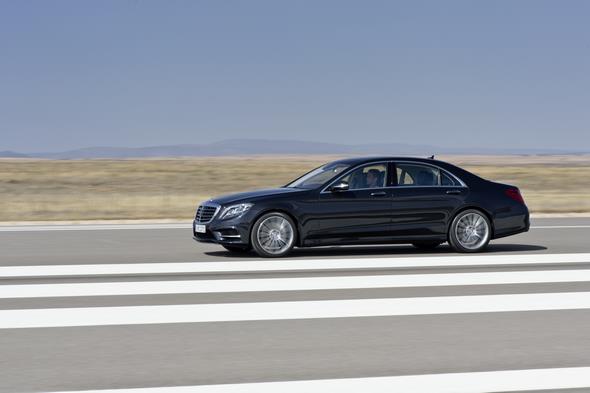
More comfort, more driver-fitness safety
Noise and vibration characteristics
As the flagship model in the Mercedes-Benz passenger car range, the S‑Class has a particularly high level of noise and vibration comfort.
Relaxed travel and working is by no means just a luxury, but also helps to ensure driver- fitness safety – a driver who is mentally and physically fit has sufficient reserves to respond quickly and correctly in critical traffic situations, and will arrive at their destination less stressed.
The development goal of performance-enhancing comfort covers a wide interdisciplinary area. It begins with NVH measures (noise, vibration, harshness) relating to the body, suspension and powertrain, plus the dimensional concept for the interior, includes all aspects of suspension, climatic, seating and noise comfort and also incorporates the development of intelligent assistance systems.
The aim of the NVH measures for the bodyshell was to better the already very good preceding model with respect to vibration and noise comfort, but without dispensing with intelligent lightweight construction methods.
The bodyshell structure of the new S-Class reaches new heights in dynamic rigidity thanks to new structural concepts and specific NVH measures in the bodyshell.
These include:
- ·Integral NVH front section concept consisting of extruded aluminium side members, cast aluminium elements at the transition between the front section and passenger cell, also at the damper domes, and integral supports as vibration-damping structural components
- ·Increased use of bracing struts for specific increases in rigidity
- ·Rear panel and cockpit cross-member of hybrid metal/plastic construction
- ·Use of foam sections in the A/B/C-pillars to increase bodyshell rigidity
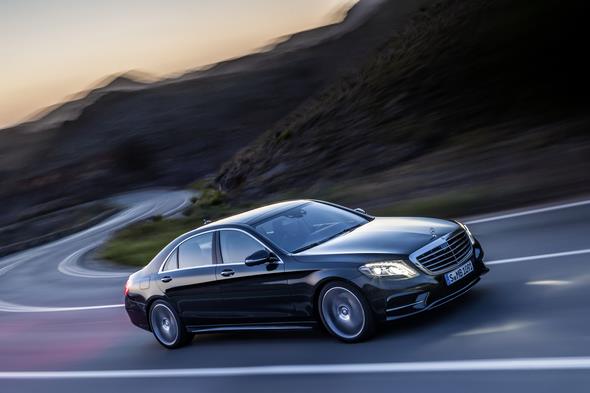
This created a very good basis for isolating engine and suspension-induced vibrations, and therefore for achieving the ambitious objectives with respect to vibration and noise comfort throughout the vehicle.
The aeroacoustic specialists took specific measures to counter wind noises during their aerodynamic development work.
To reduce high-frequency wind noise, the sealing systems around the windows and door handles were above all improved considerably.
The newly designed exterior mirror and the correspondingly shaped A-pillar with a minimised shoulder height ensure the efficient drainage of water and spray hitting the windscreen, prevent the airflow from breaking off at this point and therefore avoid noises that might enter the interior via the windscreen and side windows.
The roof structure and the automatic tilting/sliding roof module were subjected to further aeroacoustic development to improve noise comfort in this area as well.
In the case of the panoramic sliding sunroof, numerous air deflection measures, covers and seals with the appropriate geometry ensure the same high level of noise comfort as in the preceding model, despite the larger opening aperture.
A subdued, scarcely perceptible level of noise in the interior of the S-Class was the objective when configuring and coordinating the sound insulation measures. Particular attention was paid to transmitted engine noise and road roar.
During the acoustic optimisation work, the focus was both on lowering the sound pressure level and on achieving the well-balanced and comfortable overall sound perception that is a hallmark of the S-Class.
To ensure that engine noise is perceived as refined and unobtrusive in the interior, the firewall insulation was extended into the side areas of the A‑pillars.
Additional sealing levels were also added in the form of high-quality injection-moulded components.
A major contribution to the improvement in transmitted engine noise was made by improved insulation in the transmission tunnel area, as well as a modular engine partition made of plastic.
The different noise characteristics of the engines are taken into account by the use of different weights per unit area.
The electrically adjustable rear seats available as an optional extra are free-standing. High-frequency tyre noise was reduced by a large area of insulation extending from the seat surface to the rear panel and parcel shelf. Breakthroughs are kept to a minimum.
An intelligent air ducting system inside the parcel shelf allows the necessary ventilation while reducing noise transmission via the parcel shelf.
The textile underbody and wheel arch cladding has an insulating and absorptive effect which reduces high-frequency tyre noise in the interior.
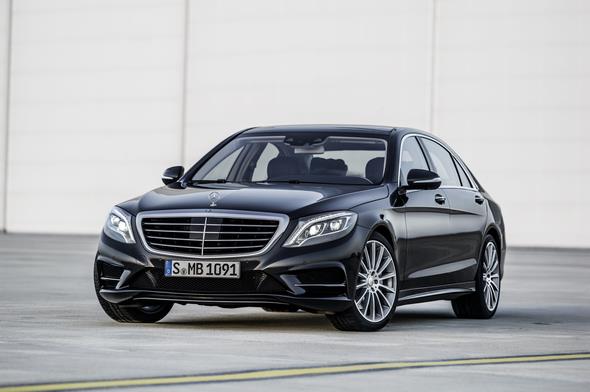
Under the microscope: performance-enhancing comfort
Comfort is also conducive to safety
Safety and comfort — the new S-Class sets new standards in both areas. The two attributes by no means only run in parallel, however: studies by the Customer Research Center (CRC) at Mercedes-Benz show that certain comfort characteristics have a direct influence on driver performance and wellbeing during and after a journey.
Comfort is also conducive to safety.
Research on driver-fitness safety, the in-house term used by Mercedes-Benz to denote comfort on long journeys, has been one of the major tasks of the CRC for over 15 years.
Well-known international scientists are regularly invited to the CRC to document the current state of research on noise comfort, vibration comfort and climatic comfort, and to analyse the effects on human performance.
The typical approach taken by the CRC studies on performance-enhancing comfort is initially to register the customer-related influencing factors.
Findings on the subject of “long-distance journeys” are obtained by means of detailed customer surveys in Germany and the USA.
One of the main findings is that uncertainty about events during a journey, e.g. traffic tailbacks, is a significant stress factor.
The second phase involves extensive practical driving tests to systematically examine the influencing factors for their relevance to performance-enhancing comfort.
For example using three externally identical E-Class test cars which noticeably but by no means dramatically differ in their vibration and noise comfort, and which have different driver seats.
36 Mercedes customers with long-distance driving experience were sent on a 410-kilometre long circular route covering motorways and country roads in each of the cars, and this route was completed three times.
The fitness of the test subjects during and after the journey was assessed using a number of indicators. During the journey, the heart rate was monitored together with muscular tension in the neck area and the frequency of frowning as an indicator of dissatisfaction.
The concentration of the hormone cortisol in the saliva gave an indication of stress levels. Directly after the journeys the test subjects were subjected to performance and alertness tests to assess their level of fitness.
They were also asked to complete questionnaires and assess their level of fatigue, for example. Indirect indicators also taken into account included the average driving speeds and especially the length of the breaks taken by the drivers.
Dr. Götz Renner summarises the conclusions from the research as a “recipe for performance-enhancing vehicles”: “Build a quiet vehicle, especially avoiding the low frequencies, add a good (driver’s) seat and first-class climate control.
Plan and schedule routes and rest breaks while avoiding tailbacks, entertain the driver, create the fundamental conditions for relaxation and assist him with functions such as the ENERGIZING massage function so that he can cope with stress and fatigue.
This vehicle will then have a fit and alert driver – also after the journey.”
These findings have already been incorporated into the new S-Class: it is quieter than any Mercedes-Benz before it.
The seating system provides unprecedented comfort, including the optional ENERGIZING massage function for all four seats.
And the new navigation system provides even more rapid and up-to-date traffic information to facilitate better route planning.
Under the microscope: history
Milestones in comfort
The luxury-class models from Mercedes-Benz are always at the vanguard of the very latest automotive technology.
Time and time again, they showcase brand new features which then come into widespread use. Here is an overview of the comfort innovations premiered by the individual S‑Class model series:
Model 220, W 187 (1951 to 1954)
- Heater with blower as optional equipment
Models 220 a/220 S/220 SE, W 180/W 128 (1954 to 1959)
- Improved spaciousness and comfort thanks to modern unitary structure
- Separately adjustable heater and blower as standard for driver and front passenger
- “Hydrak” automatic hydraulic clutch as optional equipment item
(from 1957)
- “Hydrak” automatic hydraulic clutch as optional equipment item
Models 220 b/220 Sb/220 SEb/300 SE/300 SE long-wheelbase,
W 111/W 112 (1959 to 1965)
- Four-speed automatic transmission (from 1961)
- Air suspension (300 SE, from 1961)
- Long-wheelbase version available (300 SE, from 1963)
- Central locking system as optional equipment (300 SE long-wheelbase)
Models 250 S to 300 SEL 6.3, W 108/W 109 (1965 to 1972)
- Hydropneumatic compensator spring at the rear axle
- Air suspension (300 SEL, 300 SEL 6.3, 300 SEL 3.5)
S-Class 116 series (1972 to 1980)
- Cruise control as optional equipment (from 1975)
- Hydropneumatic suspension with level control (450 SEL 6.9,
from 1975) - Automatic transmission with torque converter as optional equipment (standard for 450 SE, 450 SEL, 450 SEL 6.9)
- Large headlamps and indicators, soiling-resistant tail lights and side windows
- Coupled-link axle with anti-squat control (450 SE, 450 SEL, 450 SEL 6.9)
S-Class 126 series (1979 to 1991)
- Electrically adjustable steering column as optional equipment item (from 1985)
S-Class 140 series (1991 to 1998)
- Electronically controlled five-speed automatic transmission (standard for V8 and V12 models, from 1995)
- Speed-sensitive power steering
- Double-glazed side windows for maximum noise comfort
- Automatic climate control with activated charcoal filter and
CO/NOX-sensitive sensors as standard (S 600) or as optional equipment - Electrically folding exterior mirrors
- Power closing for doors and boot lid as optional equipment
- Adaptive Damping System ADS as optional equipment item
- PARKTRONIC electronic parking aid as standard equipment (S 600, from 1995) or as optional equipment (from 1995)
- Auto-Pilot-System APS navigation system as optional equipment (from 1995)
- TELE-AID emergency call system as optional equipment (from 1997)
- LINGUATRONIC voice-operated control system as optional equipment (from 1996)
- Seat belts with automatic height adjustment

S-Class 220 series (1998 to 2005)
- 7G-TRONIC seven-speed automatic transmission with electronic control (S 430, S 500, from 2004)
- AIRMATIC air suspension with electronically controlled Adaptive Damping System
- Active Body Control suspension as optional equipment
(standard for S 600) - Laminated glass side windows
- DISTRONIC proximity control as optional equipment
- Automatic headlamp mode
- COMAND control and display system with dynamic navigation as optional equipment
- Multi-zone automatic climate control with individual control at each seat depending on the sun’s position
- Luxury seats with ventilation and dynamic multicontour backrest as optional equipment
- KEYLESS-GO access and drive authorisation system as an optional extra
S-Class 221 series (from 2005)
- 7G-TRONIC seven-speed automatic transmission with electronic control and DIRECT SELECT steering wheel gearshift
- Active Body Control (ABC) with crosswind stabilisation as an optional extra
- Further development of DISTRONIC PLUS adaptive cruise control (with braking to standstill) as an optional extra
- New control concept with a COMAND Controller on the transmission tunnel
- Dynamic multicontour seat with new massage function
- Foot-operated parking brake with electric assistance
- SPLITVIEW display as an optional extra (from 2009)
- Parking Assist as an optional extra
- Adaptive Highbeam Assist as an optional extra (from 2009)
- Speed Limit Assist as an optional extra (from 2009)
- Night View Assist based on infra-red technology as an optional extra

